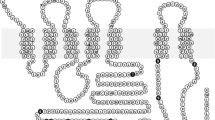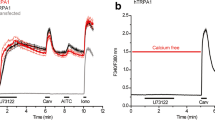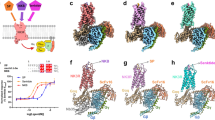Abstract
The human tachykinin NK2 receptor stably expressed in Chinese hamster ovary cells (CHO-hNK2R cells) was characterized by studying the effect of neurokinin A (NKA), the preferred natural ligand, and that of other agonists and antagonists in both binding experiments and functional assays. Competition experiments using [125I]NKA showed that CHO-hNK2R cells express binding sites which have high affinity for NKA (K i=3.4±0.9 nM), GR 64349 (K i=12±3 nM) and [βAla8]NKA(4–10) (K i=21±8 nM) and for the antagonists MEN 10627 (K i=0.55±0.2 nM), and MEN 11420 (K i=2.4±0.8 nM). In contrast, the tachykinin NK1 and NK3 receptor agonists [Sar9,Met(O2)11]SP and senktide, respectively, were recognized with low affinity (K i>10 μM). NKA (EC50=68±18 nM) induced a rapid and concentration-dependent increase in the intracellular level of inositoltrisphosphate (IP3). The concentration-response curve to GR 64349 (EC50=155±14 nM) was close to that of NKA, whereas [βAla8]NKA(4–10) (EC50=445±78 nM) and SP (EC50=3197±669 nM) were 7- and 50-fold less potent, respectively. In addition, NKA stimulated the release of arachidonic acid and the production of prostaglandin E2 (PGE2) in a concentration-dependent manner. Also in this assay, NKA was found to be more potent than the other agonists tested (the EC50 values were 3±0.3, 9±3, 7.8±0.9 and 217±37 nM for NKA, GR 64349, [βAla8]NKA(4–10) and SP, respectively). MEN 10627 and MEN 11420 were potent and competitive antagonists in blocking NKA-induced IP3 formation and PGE2 release: MEN 10627 and MEN 11420 displayed comparable potencies in blocking the two functional responses initiated by occupancy of the NK2 receptor by NKA. Pretreatment of the cells with pertussis toxin (500 ng/ml for 18 h) did not significantly modify the basal or stimulated phosphatidylinositol turnover but reduced the basal and NKA-induced PGE2 release by about 35%. The phospholipase C inhibitor U-73122 (10 μM) prevented the NKA-induced formation of IP3 but did not affect PGE2 release. Conversely, the phospholipase A2 inhibitor quinacrine (100 μM) blocked the release of arachidonic acid and PGE2 without affecting the NKA-stimulated formation of IP3. Chelation of extracellular calcium with 3 mM EGTA inhibited the NKA-induced PGE2 release by 81% but was without effect on basal and NKA-stimulated IP3 production. The calcium channel blockers verapamil (10 μM) and ω-conotoxin GVIA (0.1 μM) did not modify the basal PGE2 production and had no significant effect on the response to tachykinins while the blocker of non-selective cation channels, SKF-96365 (10 μM), inhibited the response to NKA by about 74%. SKF-96365 did not affect the basal or the NKA-induced IP3 formation. In conclusion, our data demonstrate that the human tachykinin NK2 receptor expressed in CHO cells displays binding affinity and functional properties which are those of a native NK2 receptor. No pharmacological evidence for heterogeneity of the human NK2 receptor was obtained in this study. Our findings indicate that the human tachykinin NK2 receptor is independently coupled to both PLC and PLA2 signaling pathways. Activation of the PLA2 pathway may be linked to the opening of a voltage-independent cation channel which activates a Ca2+-dependent PLA2.
Similar content being viewed by others

Author information
Authors and Affiliations
Additional information
Received: 7 April 1998 / Accepted: 17 July 1998
Rights and permissions
About this article
Cite this article
Catalioto, RM., Cucchi, P., Renzetti, A. et al. Independent coupling of the human tachykinin NK2 receptor to phospholipases C and A2 in transfected Chinese hamster ovary cells. Naunyn-Schmiedeberg's Arch Pharmacol 358, 395–403 (1998). https://doi.org/10.1007/PL00005270
Issue Date:
DOI: https://doi.org/10.1007/PL00005270



